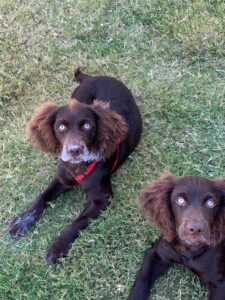It all began on a seemingly routine and peaceful night last week. Time for bed was announced. We started gathering up supplies and devices and ourselves in a disorganized fashion and that’s when I opened the back door to let the dogs out.
Actually, everything was naughtily quiet until the waft of gagging odor came in the back door. Then the dogs were hollering, I was hollering and everything took place in super speed after that. Jeff turned into a Knight in Shining Armor by using the water hose to get the dogs away from the skunk and back on the porch.
After we took a moment to let our panic subside the real adventure began. These wriggly fireballs that stunk weren’t going back in the house till we washed the skunk spray off! A lot of research happened in a short amount of time that night and we were moderately successful, mostly successful at making the situation livable.
One thing, the dogs were carefully monitored for any negative impact and Jeff had their shot records up immediately to make sure they (and us) were protected against the diseases that skunks carry.
If this happens to anyone reading our post I encourage you to seek veterinary assistance with questions or concerns.
Skunks in hill country
5 species.:
I was surprised to learn we have 5 species of skunk in Texas. We are a large area and that leads us to have more species than other states. Jeff clearly noticed a stripe so that causes me to think we experienced the most common variety which is the Striped Skunk (Mephitis mephitis).
If you are out and about in the different regions of Texas you could run into hooded, spotted, striped or hog-nosed skunks (though I’d actually rather not). No matter which species of skunk you get a look at, use common sense and caution and a great Keep Away sign in your thoughts. Simply leave them alone. Skunks may appear furry and fun but they are a leading carrier of rabies in Texas.
Positive and Negative:
It is interesting how nature will often wrap positive attributes and negative attributes up with one bow. Skunks have a major beneficial aspect to their presence. They are excellent hunters for bugs, grubs, small rodents and spiders. On the minus side of the scale, they also are hearty eaters of poultry and eggs, garbage, or any pet food left available outside. They will nest under sheds, barns, houses, and decks, anywhere with a bit of access so block up those entrances with buried wire fencing such as hardware cloth. They just smell really bad.
How they warn you before spraying you.:
When you encounter a skunk watch for their warning signs that show the spray is coming. They will hunch up their back and begin to raise their tail but not the tip. You may notice a stamping of their forefeet next and lastly look out if the tip of the tail goes up. Should the skunk be caught off guard they can spray without warning to defend themselves. I thought it interesting that they can aim left, right, over the back as well as straight on with a range of 10 – 12 feet out. Its good to note that a skunk can direct multiple shots at the perceived attacker with equal power.
What if dogs get sprayed?
Where were they hit? Face is more serious than the body.:
Oh no! The worst has happened and your dog is covered in the most obnoxious scent. You are going to be a detective first. Where did puppy come in contact with the spray? Are their eyes red and streaming tears? Do you see foam coming from the mouth? If you see these it means the dog’s face took a hit and you need to take extra steps in caring for your friend. Using clear and cool water rinse the dog’s face well. Then bathe puppy (making sure you keep this away from their eyes) with a mixture of 1 quart 3% hydrogen peroxide, 1/4 cup baking soda and 1-2 teaspoons of dishwashing liquid (we used Dawn).
We had to follow through with this mixture because it was the middle of the night when our catastrophe occurred. You run a big risk that this will cause bleaching to your dog’s fur but it will grow out.
If you are able to get to a store there are special shampoos just for removing the skunk spray from the dog’s fur.
Do not let this mixture get near the dogs eyes!
Get your dogs wet and as soon as the mixture begins to bubble massage into the dog’s body. Leave it on for 5 minutes and then rinse carefully. Repeat this washing procedure with fresh mixture if you can still smell a skunk odor. We only needed one application. Throw away any extra mixture.
Now, use your regular dog shampoo and rinse very well. Towel dry and take a whiff. We were grateful to find the smell gone pretty much. My daughter says she catches a whiff every now and then which is worrisome because you don’t want that smell on your furniture!
Double check shot records and watch for up to three days. Jeff is so great because he could pull up their records right away and we are up to date on all the vaccines. You want to keep a close eye on your dog because skunk spray can cause some eye problems if that is where it lands. The spray can in some cases cause a form of anemia which is treatable by your veterinarian.
If you think the vet should look at your dog then they should. It is better to have an ounce of reassurance than a pound of regret.
How to deter skunks?
It is important to understand skunks are a nocturnal species. They tend to hunt, forage and move about quite often in the dusk and dawn hours of low light as well as during the night. So, your key deterrent will be a good strong light. They have highly sensitive eyes and a bright beam will send most scurrying away. We are using our porch light and some strong flashlights right now but are shopping the motion detector lighting as well. We shine down the yard before letting the dogs out these days.
The first thing the next morning Jeff and I did was to walk around the yard searching out places the skunk could have made a home under our deck. We secured the one area where two boards didn’t quite meet and mounded gravel against the boards. The best advice is to use sturdy hardware cloth and if possible bury the wire fencing about a foot deep.
Fencing is a deterrent but check to see if there has been any burrowing underneath happening. I’m glad we placed the kitchen garden inside fencing to protect it from the dogs now. It may at least slow these critters down.
I had been cleaning up the garden, as we do in late summer, and had amassed a pile of branch trimmings, weed pulling and dead flowers. We got every bit of that bagged up and ready for the recycling team to pick up. You want to make sure there are no hidey holes available to a skunk.
This last point is to remove all food sources. Jeff and I don’t feed our dogs outside so that was okay. I feel even water sources could be attractive when the weather is so hot. Everyone wants to keep the garden cleaned up of any dropped fruit or extra veggies. Remember the skunk is omnivorous. They are also ready to eat whatever is in their way so make sure your garbage cans have heavy tops or other barricades to entry.
Though I didn’t find this in my research it makes sense that these critters would not like to be in an actively pruned garden. This next year my goal is to follow a pruning schedule more rigourssly and create a bit less habitat for them.
Conclusion:
I don’t know why it never occurred to me that a skunk could visit our yard. We see a great number of skunks locally each year. They are especially mobile in the spring during mating season and are all along the roadways. The other thing is we have aa wildlife preserve quite nearby. We have a diverse amount of wildlife crossing in front of our yard almost every days.
That said, I am now forewarned and forever more on guard should another skunk care to say hello in my yard.
References
- Online: Texas Parks and Wildlife, “Skunks”
- Online: Texas Parks and Wildlife, “The Big Stink”. Author: Russell Roe
- Online: Texas A&M Agrilife Extension L-1901, “Managing Skunk Damage”
- Online: Cornell Richard P. Riney Canine Health Center, “What to do when your dog gets skunked” Author: Dr. Aly Cohen
- Skunk photo by Jack Bulmer




